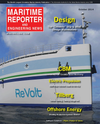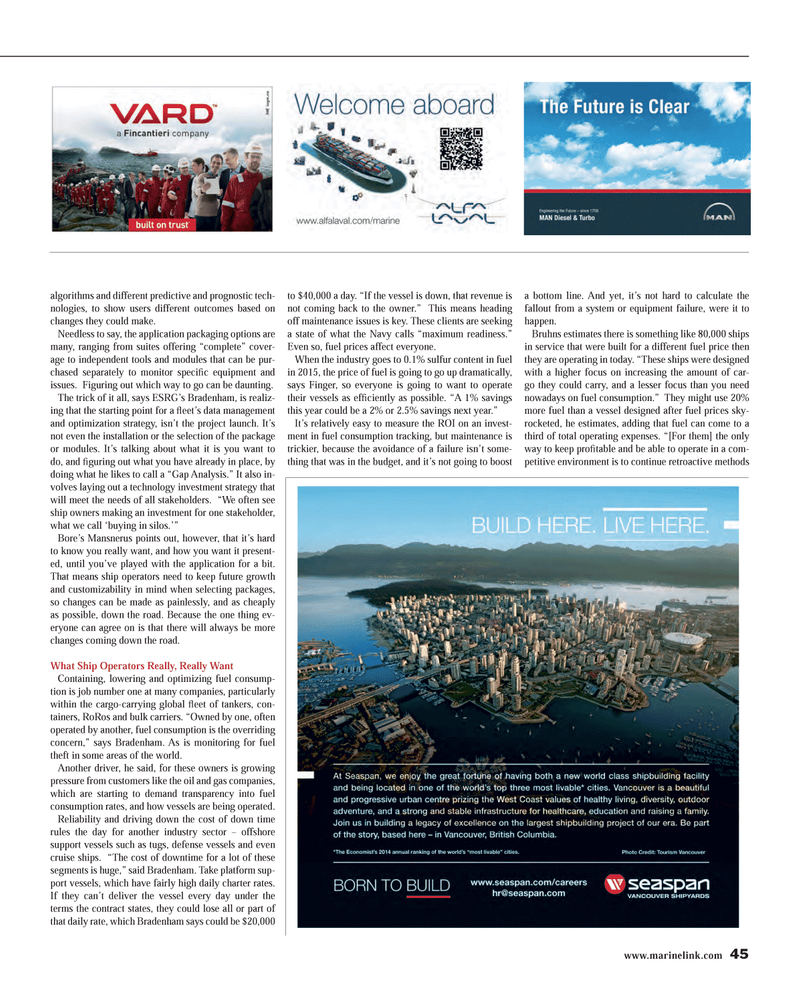
Page 4th Cover: of Maritime Reporter Magazine (October 2014)
Marine Design Edition
Read this page in Pdf, Flash or Html5 edition of October 2014 Maritime Reporter Magazine
www.marinelink.com 45 algorithms and different predictive and prognostic tech- nologies, to show users different outcomes based on changes they could make.
Needless to say, the application packaging options are many, ranging from suites offering “complete” cover- age to independent tools and modules that can be pur- chased separately to monitor specifi c equipment and issues. Figuring out which way to go can be daunting.
The trick of it all, says ESRG’s Bradenham, is realiz- ing that the starting point for a fl eet’s data management and optimization strategy, isn’t the project launch. It’s not even the installation or the selection of the package or modules. It’s talking about what it is you want to do, and fi guring out what you have already in place, by doing what he likes to call a “Gap Analysis.” It also in- volves laying out a technology investment strategy that will meet the needs of all stakeholders. “We often see ship owners making an investment for one stakeholder, what we call ‘buying in silos.’”
Bore’s Mansnerus points out, however, that it’s hard to know you really want, and how you want it present- ed, until you’ve played with the application for a bit.
That means ship operators need to keep future growth and customizability in mind when selecting packages, so changes can be made as painlessly, and as cheaply as possible, down the road. Because the one thing ev- eryone can agree on is that there will always be more changes coming down the road.
What Ship Operators Really, Really Want
Containing, lowering and optimizing fuel consump- tion is job number one at many companies, particularly within the cargo-carrying global fl eet of tankers, con- tainers, RoRos and bulk carriers. “Owned by one, often operated by another, fuel consumption is the overriding concern,” says Bradenham. As is monitoring for fuel theft in some areas of the world.
Another driver, he said, for these owners is growing pressure from customers like the oil and gas companies, which are starting to demand transparency into fuel consumption rates, and how vessels are being operated.
Reliability and driving down the cost of down time rules the day for another industry sector – offshore support vessels such as tugs, defense vessels and even cruise ships. “The cost of downtime for a lot of these segments is huge,” said Bradenham. Take platform sup- port vessels, which have fairly high daily charter rates.
If they can’t deliver the vessel every day under the terms the contract states, they could lose all or part of that daily rate, which Bradenham says could be $20,000 to $40,000 a day. “If the vessel is down, that revenue is not coming back to the owner.” This means heading off maintenance issues is key. These clients are seeking a state of what the Navy calls “maximum readiness.”
Even so, fuel prices affect everyone.
When the industry goes to 0.1% sulfur content in fuel in 2015, the price of fuel is going to go up dramatically, says Finger, so everyone is going to want to operate their vessels as effi ciently as possible. “A 1% savings this year could be a 2% or 2.5% savings next year.”
It’s relatively easy to measure the ROI on an invest- ment in fuel consumption tracking, but maintenance is trickier, because the avoidance of a failure isn’t some- thing that was in the budget, and it’s not going to boost a bottom line. And yet, it’s not hard to calculate the fallout from a system or equipment failure, were it to happen.
Bruhns estimates there is something like 80,000 ships in service that were built for a different fuel price then they are operating in today. “These ships were designed with a higher focus on increasing the amount of car- go they could carry, and a lesser focus than you need nowadays on fuel consumption.” They might use 20% more fuel than a vessel designed after fuel prices sky- rocketed, he estimates, adding that fuel can come to a third of total operating expenses. “[For them] the only way to keep profi table and be able to operate in a com- petitive environment is to continue retroactive methods
MR #10 (40-49).indd 45 10/1/2014 10:22:25 AM

 3rd Cover
3rd Cover

